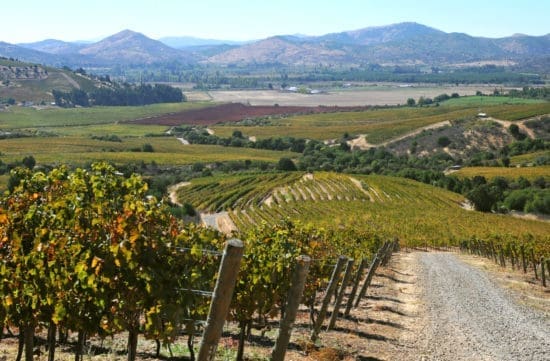How mountains influence wine


Geography has a significant impact on the flavor of wine. It determines the growing conditions and how grapes ripen, including factors such as the soil type, temperature, and elevation of the vineyards, particularly those in the mountains.
The term terroir is commonly used in the world of wine. It refers to the conditions in which grapes are grown and directly influenced by geography. The soil, temperature, altitude, and elevation all play a significant role in determining the character of the final wine. Some experts even argue that the vineyard’s location could be more crucial than the type of grape used in the winemaking process.
Related to mountains and valleys, altitude and elevation are conclusive factors in viticulture and, therefore, in the taste of wine. How so? Vines that grow at altitude have greater exposure to solar radiation (fundamental for the development of aromas) but are also exposed to lower temperatures, slowing the ripening process. The vineyard’s position plays a crucial role in the quality of the grapes produced. Winegrowers carefully choose the vineyard’s location to ensure it receives adequate sunlight, resulting in the grapes’ ideal ripeness and balance. For instance, Barolo wines are an excellent example of wines that receive morning sunlight and are internationally renowned for their quality.

Altitude and elevation are crucial factors in viticulture that affect the taste of wine. Vines that grow at higher altitudes have more exposure to solar radiation, which is fundamental for developing aromas.
However, they are also exposed to lower temperatures, slowing the ripening process. As a result, the grapes from these vines tend to have higher acidity and a more complex aromatic profile. Winegrowers play a vital role in choosing the ideal position of the vineyard to ensure that the grapes receive enough sunlight, achieve good ripeness, and maintain balanced acidity levels. For instance, vineyards that face the morning sun, like the ones producing the internationally praised wines of Barolo, can create excellent wines. A fundamental role in choosing the ideal position of the vineyard is that it can receive sunlight and achieve good ripeness and balanced grapes. A perfect example is the vineyards that receive the morning sun, as in the case of the internationally praised wines of Barolo.
However, there is something about high-altitude wines that can be perceived quickly. They are characterized by a high concentration of tannins (very elegant), and therefore, they usually need more time in barrel and bottle aging.

Although in grape-producing countries with hot climates, as is the case in Argentina or Chile, the altitude offered by the Coastal and Andes Mountains and the elevation in their valleys can offer the vineyards some relief from the heat. Statistically, for every 100 meters above sea level, the temperature decreases by 0.6 degrees Celsius. In addition, the thermal amplitude between day and night is also greater, reinforcing the wines’ freshness.
The Gran Reserva Cabernet Sauvignon is produced from grapes grown in the Palo Santo vineyard, located 180 meters above sea level. This privileged growth area extends along hills and terraces south of the Tinguiririca River. The wine has a significant concentration of flavors, and the influence of the river moderates temperatures; thus, the altitude is not expressed dramatically. Similarly, the Gran Reserva Carmenère originates from vines grown in the Peumo vineyard, rooted in the terraces and hills of the coastal mountains. This vineyard is situated 170 meters above sea level and grows side by side along the Cachapoal River. Both wines are dry and fresh, but Gran Reserva Carmenère has a crisp character that is very well perceived when served with red meats and pieces of aged cheese.

The hills can offer protection to the vineyards against the cold winds that run through the valleys, helping to create perfect microclimates for the production of certain varieties and providing warmth in colder areas.
As you can see, their participation is fundamental. Thanks to the characteristics they bring to wines, such as acidity, they have great potential for aging, longevity, and evolution in the bottle. On International Mountain Day, we invite you to become aware of these natural jewels that, in addition to supplying fresh water for humanity and housing half of the world’s biodiversity reserve, are threatened by climate change today.
We comply with the highest standards of verified social and environmental performance, transparency, and legal responsibility to balance benefit and purpose.
We adopt an Impact Business Model, creating beneficial links between business, community, and environment.
The Gran Reserva vineyards are an important part of the project to conserve native forest areas and protect local biodiversity. Our native forests have the ability to retain rainwater and control the kind of climate change that results from water shortages.
We take care of 1,432 hectares of protected forests and, on average per vineyard, a total of 105 species of fauna and 48 species of registered flora.
Our effort to preserve nature begins with responsible water consumption. 99% of the water we use comes from surface and subterranean sources.
Our vineyards are drip irrigated, which translates to a 90% efficiency on water consumption, and over the past 3 years, we’ve reduced our water footprint by 10%.
All of our winemaking processes require the use of energy. Our choice to invest in clean, renewable energy reflects our desire to co-create a sustainable planet for the future.
100% of the electricity used to make the wines in the Gran Reserva collection come from renewable sources, including solar energy.
Concha y Toro has been certified under the Wines of Chile Sustainability Code since 2012, which means that our vineyards are officially recognized as sustainable vineyards.
The wines in our Gran Reserva collection are crafted entirely from estate-owned grapes in sustainably managed vineyards.